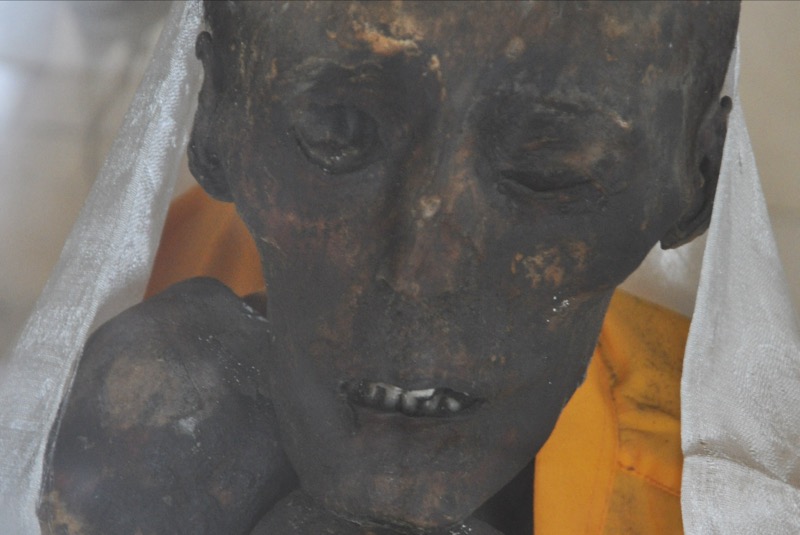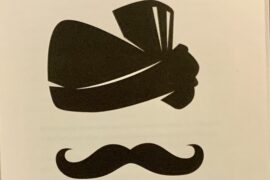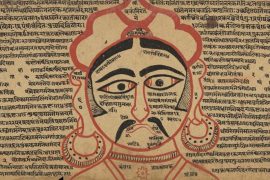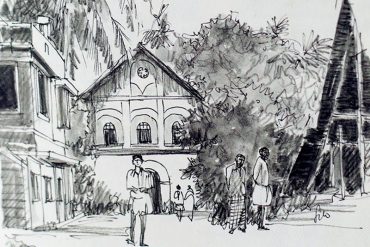One would suppose mummies are embalmed, wrapped in cloth, and found in Egypt’s pyramids or under many layers of glass in museums. However, a journey across the Indian Himalayas exposes the strange and ancient practice of self-mummification.
A five-hundred-year-old Mummy is preserved in the tiny village of Gue, in the state of Himachal Pradesh, just nine kilometres from the Tibetan border. The mummy’s teeth are still visible through his open lips, and a thin pane of glass covers it.
The beautiful landscape around the Spiti River is one of the country’s least inhabited areas. Tibetan Buddhism has also significantly affected it. Gue comprises a few mud homes and one tiny, box-shaped, single-room concrete building where the mummy is found.
These are the bones of a Buddhist monk called Sangha Tenzin, who lived in the fifteenth century. His corpse was found when the stupa that housed him collapsed during an earthquake in 1975.
Despite being exposed to the weather, without artificial preservation, the corpse has deteriorated little since then. His skin is darkened and taut, his hair intact, and he sits firmly, wrapping his leg with his fist and resting his chin on his knee.
The mummy is uncanny. If one is left alone in the room with it, they will most likely think at least once about whether Tenzin will rise from sleep and come right at you. Dead for over 500 years now, his body is passing the tests of time.
Sangha Tenzin’s mummification is a process of self-preservation practised by Buddhist monks of Yamagata in Northern Japan between the eleventh and nineteenth centuries. The self-mummification process, Sokushinbutsu, was performed by devout spiritual gurus from the Shingon sect. They starved themselves to death to achieve the greatest level of enlightenment.
In the eleventh century, a hagiography of Kūkai emerged, stating that after he died in 835, the monk crawled inside his grave and entered nyūjō, a deep state of concentration that causes suspended animation. According to this hagiography, Kai intends to appear in 5.67 million years to lead a certain number of souls into nirvana.
The earliest documented effort at becoming a sokushinbutsu, or “a Buddha in this very body,” via self-mummification occurred in the late eleventh century. In 1081, a man named Shōjin buried himself alive to follow Kūkai into nyūjō. He, too, hoped to return in the long future for the benefit of humanity, but when Shōjin’s followers went to collect his corpse, the rot had set in.
It would take almost two centuries of trial and error before someone found out how to mummify himself and, they thought, to cheat death, one has to enter an everlasting state of meditation.
The procedures for mummifying one’s own body were very strenuous and painful. For the first 1,000 days, the monks abstained from all food except nuts, seeds, fruits, and berries and participated in strenuous physical exerciseto rid themselves of all body fat.
For the following thousand days, their food consisted only of bark and roots. Toward the end of this time, they consumed toxic tea prepared from the sap of the Urushi tree, which caused vomiting and a fast loss of bodily fluids. The tea also served as a preservative, killing off maggots and germs that would otherwise cause the corpse to deteriorate after death.
After more than six years of painful training, the monk would lock himself in a stone tomb slightly bigger than his torso and enter a state of meditation. The tomb was supplied with oxygen through a tiny bamboo airline. The monk rang a bell daily to let the outside world know he was still alive. When the bell would not ring anymore, the tube would be removed, and the tomb would be shut for the ritual’s last thousand days.
If the monk succeeded in self-mummification, they were considered successful and revered as living buddhas. Even if they failed, they were still deeply respected for trying.
Sangha Tenzin’s mummification seems to have followed a similar ritual. Professor Victor H Mair of the University of Pennsylvania’s Museum of Archaeology and Anthropology conducted research that drew similarities between Sangha Tenzin and the Buddhist monks of Yamagata in northern Japan, eliciting information about the procedure. His investigation is chronicled in the documentary The Mystery of the Tibetan Mummy.
Mair’s team discovered significant residual nitrogen levels in Tenzin’s body, indicating extended fasting. Meditation may have also played a part since Tenzin wore a prominent gomtag, or a meditation belt, around his neck and legs to assist him in maintaining his posture until death. According to local legend, the monk Sangha Tenzin begged his disciples to allow him to mummify himself after a catastrophic scorpion infestation left the region afflicted with illness, said Thundup.
In 2014, a millennium-old statue of the Buddha was loaned to the Drents Museum in the Netherlands. It was the first time that the statue had been shown outside China. A medical exam at the Meander Medical Centre at Amersfoort revealed that inside the statue was an ancient secret—a mummified Buddhist Monk was sitting in a lotus position.
Examination of the monk revealed that the remains belonged to a Buddhist master, Liuquan, a disciple of the Chinese Meditation School who died about 1100 A.D. It is believed that the monk used the same self-mummification process to transform himself into a ‘Living Buddha.’
In 2015, another well-preserved two-hundred-year-old self-mummified monk was discovered in Mongolia, a bastion of Tibetan Buddhism. The monk was frozen, just like others found, sitting in a lotus position with his body surviving for over 200 years, still intact.
In the early 1900s, Japan passed a law banning self-mummification; However, the practice seems to have prevailed in other parts of Asia. Luang Pho Dang successfully self-mummified himself in the 1970s, and his body was venerated at the Wat Khunaram Temple in Thailand. People visit him and make offerings to the popular monk.
Sangha Tenzin’s remains are also protected at a haven in the cold and lonely Spiti region of the Indian Himalayas. Living Buddha or not, something eerie about the mummy settles in the atmosphere just from the look of it and the legends surrounding it.
-30-
Copyright©Madras Courier, All Rights Reserved. You may share using our article tools. Please don't cut articles from madrascourier.com and redistribute by email, post to the web, mobile phone or social media.Please send in your feed back and comments to [email protected]











